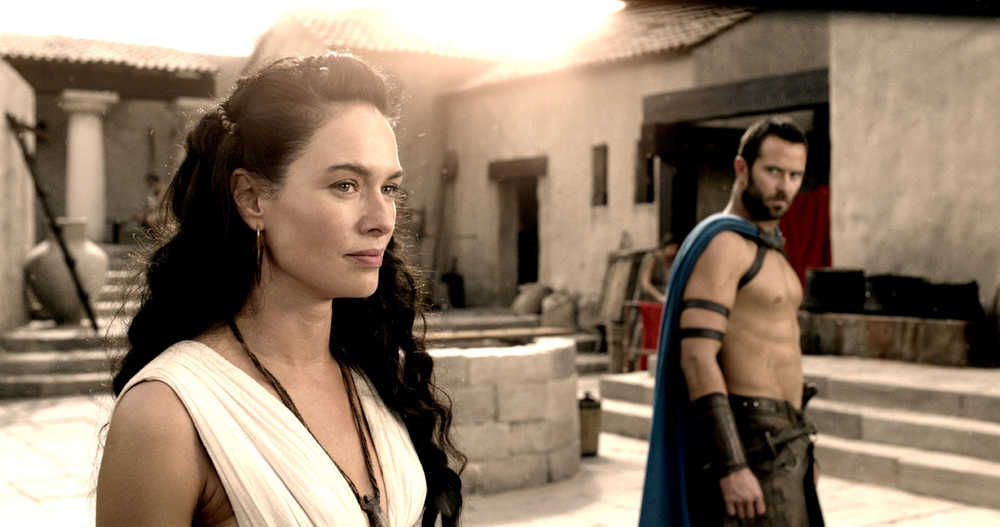1hr 42min
Rated R
Warner Bros. Pictures
Action/Adventure/Drama
It seems like sort of an odd choice to make a sequel to a movie like “300,” the splashy, artsy, blood-soaked sword and sandal epic of 2006. After all, that movie was, if nothing else, self-contained. Spoiler alert: everybody dies at the end. Also, of all the tales surrounding the Greco-Persian Wars, the Battle of Thermopylae, which was detailed in “300” and relates a powerfully simple tale of determination and martyrdom, would be the one to tell. The rest of the histories are more complicated with myriad moving parts and lots of different characters, each of whom have similarly sounding, unpronounceable names like Themistokles and Aesyklos. So, when I heard they were working on a sequel to “300,” I naturally assumed it would a be a cheap, maybe even direct to video, cash grab with very little to offer. I was definitely wrong on that point, and while I can’t say “Rise of an Empire” is as good as its predecessor, it is certainly ambitious.
The movie opens with Queen Gorgo, widow to Spartan King Leonidas, regaling a platoon of armored warriors with tales of bygone days. This tale is for her theatrical audience, however, more than her military one. In summary, you know what happened in “300?” Well, here’s the backstory. Ten years previous, the Greeks had fought the Persian king Darius to a standstill at Marathon. In the battle, a valiant Greek soldier named Themistokles managed to mortally wound Darius but neglected to kill his son, Xerxes. At this point, Xerxes resembles nothing of the ten-foot-tall god-king he will become, but give the boy time. Darius, at home on his death bed, warns Xerxes to leave the Greeks alone, but the King’s top aide, a dangerous warrior named Artemesia disagrees. Artemesia has her own backstory later in the movie, but suffice it to say she’s deadly and hates the Greeks. She alternately bullies and mentors young Xerxes, ultimately pushing him into godhood and engineering a massive attack on Greece, part of which will be so memorably portrayed in the original “300.” The tale continues, going from prequel, to the parallel tale of a massive naval battle between Themistokles and Artemesia. Eventually, the film bypasses the events of “300,” becoming a true sequel, surprisingly wrapping up the story in under two hours.
Stylistically, “Rise of an Empire” is nearly identical to “300,” with it’s beautifully staged settings, rich color scheme, and dramatic slo-mo action sequences. It works, but not quite as well. This is partly because it’s not quite as well done – the colors are slightly less vibrant, the slo-mo a little too prevalent, and partly because it’s been done before. The original “300” was a kind of revelation of how far CG can take you cinematically when you throw out all vestiges of trying to make things look “real.” Zack Snyder created something gorgeous and garish all at once, putting a major emphasis on style over substance. This new film does the same thing, but with a much more complicated story and a sense of having been-there-done-that – “Rise of an Empire” suffers somewhat in comparison.
Plot-wise the film has highs and lows. On the one hand, I was very impressed at the bookending nature of the movie, of how it really envelopes its predecessor instead of simply rehashing it. I’ve never seen a sequel, outside of “The Godfather Part II” that does that – good company to be in. Many of the original actors are back, some in small, surprising ways, although the producers are saved from paying the massive salaries of Gerard Butler and Michael Fassbender, both of whom were relatively unknown when they starred in “300,” and whose characters conveniently died in that film. Australian actor Sullivan Stapeleton is fine as Themistokles, though he lacks some of Butler’s bombastic charisma. Eva Green, as Artemesia, however, completely fires up any scene she’s in. It’s scene chewing, but she’s a lot of fun to watch. The problem is, however, that with all the convoluted flashbacks and flashforwards, back-stories and intrigue from this city-state or that – it becomes difficult to keep track of who is who, when is when, and what exactly is going on. As well, the extreme stylized nature of the film doesn’t lend itself as well to such a wide spanning story.
This is not to suggest that “300: Rise of an Empire” isn’t entertaining. It is, but at times it’s a little much. I also have to say, the title makes no sense whatsoever. “300” refers very specifically to the first movie and not at all to this one. And “Rise of an Empire?” Whose empire? The Persians had an empire and were in the process of losing it. The Greeks didn’t have an empire. I don’t know what they’re referring to, but that’s nitpicking, I guess. On the plus side, this movie finally showed me what all the hubbub over 3D is about. For 99% of the film, it’s just your typical, take it or leave it, eek-there’s-a-spear-coming-at-me kind of 3D – but one scene, one thirty-second segment was pretty amazing. Xerxes is walking out onto a high dais looking down from atop his palace, and the camera pans up showing the god-king in the foreground and the entire city, a thousand feet below. For just a second it looked as if the entire screen had opened up and there was literally another world inside and that I was hovering above it. I actually had to grab the arms of my seat before the feeling passed. It was weird and I though to myself, “Oh – so that’s what the big deal is.” The whole movie doesn’t live up to that one moment, but the remaining hour and fifty minutes are half-bad. Grade: B
“300: Rise of an Empire” is rated R for bloody violence, gruesome battle scenes, sexuality, nudity and language.

